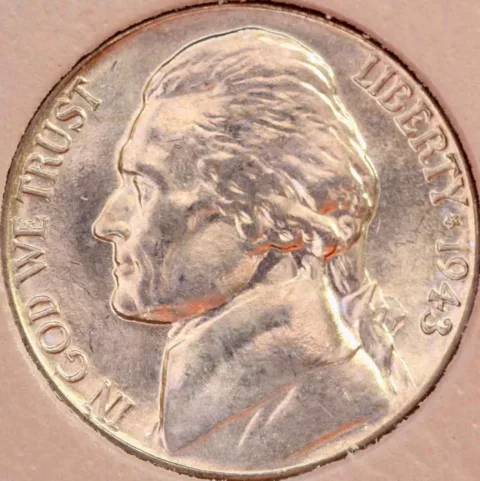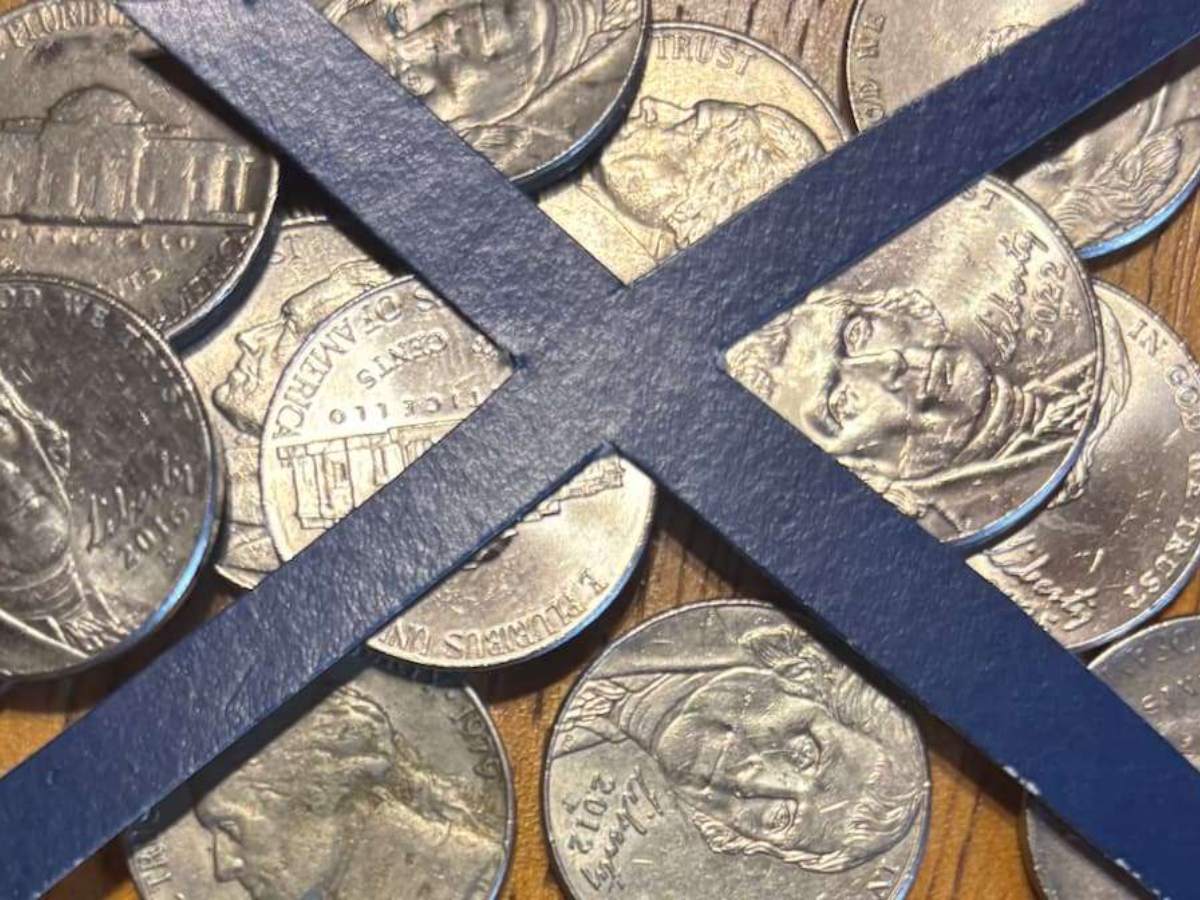
Did you know all 1943 nickels are worth more than face value?
The 1943 Jefferson nickel is made from silver, and it’s becoming scarce in pocket change.
So…
- How can you tell a 1943 silver nickel from regular nickels?
- And how much are 1943 Jefferson nickels worth?
1943 Regular Nickels vs. Silver Nickels
Like all 1943 coins, the Jefferson nickels from that year are both highly collectible and considered historic relics from the past.
Why were 1943 nickels made from valuable silver?
With the United States engaged in World War II, the nation needed to ration important materials and resources for the war effort overseas in Europe, Asia, and North Africa. Nickel was important for producing artillery — so the United States government permitted the mint to swap out the 75% copper / 25% nickel composition for a special alloy made from 56% copper, 35% silver, and 9% manganese.
The silver wartime alloy was first used to make 1942 nickels and continued through 1945 — the year World War II ended.
Silver nickels are easily distinguishable from regular nickels.
All you need to do to see if you’ve got a silver war nickel is to flip the coin over to the reverse (tails side). All silver war nickels have a large mintmark over the dome of Monticello indicating whether the coin was minted at the Philadelphia Mint (P), Denver Mint (D), or San Francisco Mint (S).
While all 1943 nickels are made from silver, it nevertheless helps to look for the mintmark — which can be easier to spot on silver nickels than the date, which is small and located on the obverse (heads side).
How Much Is A 1943 Nickel Worth?
So, 1943 Jefferson nickels are worth more than face value, but exactly how much more are these old silver coins worth?
Let’s take a look…
1943-P Nickel Value
The 1943-P Jefferson nickel had the highest output of all 1943 silver nickels, with a mintage of 271,165,000 pieces.
While all war nickels are relatively scarce, the 1943-P silver nickels are the most common of the date. It’s possible to find 1943 nickels in circulation, something often made easier by searching nickel rolls.
Worn examples of a 1943-P nickel are worth about $1 to $2, when silver is in the range of value of about $10 to $20 per ounce. Uncirculated specimens are worth around $3 to $5 each.
The record price for the 1943-P nickel is $14,687.50 — which is the amount paid for a specimen graded by Professional Coin Grading Service (PCGS) as MS68 with Full Steps details.
1943-D Nickel Value
The 1943-D Jefferson nickel from the Denver Mint saw a mintage of only 15,294,000 — which was the lowest mintage of the three business-strike nickels made in 1943.
While this is one of the rarest of the war nickels, it can still be found in circulation with careful searching.
Worn examples are worth about $2 to $3, and uncirculated specimens have a value of $10 to $15 apiece.
The all-time record price for a 1943-D Jefferson nickel is $6,600 for a PCGS-graded example certified as MS67+ Full Steps.
1943-S Nickel Value
With a mintage of 104,060,000, the 1943-S nickel is much more common than its Denver Mint counterpart.
As with the other 1943 coins, looking through bank rolls is a great way to find these old nickels for face value.
The 1943-S Jefferson nickel is generally worth $1 to $2 in well-worn grades. Uncirculated examples are worth about $10 and up.
One 1943-S nickel fetched $9,000 for an example graded by PCGS as MS68 Full Steps.
1943 Proof Nickel Value
If you came here looking for 1943 proof nickel values, unfortunately you may not get the answer you’re looking for.
The U.S. Mint stopped making proof coins from 1943 through 1949 to concentrate production capacity on making coins for circulation and also to strike war medals.
Rare 1943 Nickel Errors & Varieties
There are plenty of errors and varieties on 1943 nickels!
Here are several rare 1943 nickels you should be looking for…
1943-P Doubled Die Nickels
One of the most popular types of varieties is the doubled die error coin.
On the 1943 nickel, the doubled die obverse is evident in the lettering across the obverse — including the inscriptions “IN GOD WE TRUST,” “LIBERTY,” and the date “1943”.
Perhaps the weirdest sign of doubling on a 1943 doubled die nickel is the appearance of a second eye in front of Jefferson’s main eye on the coin.
Worn 1943 doubled die nickels are worth about $150, while uncirculated specimens take $200 or more. The claim for the all-time record price goes to a specimen graded by PCGS as MS67 Full Steps, which took $11,500.
1943-P 3 Over 2 Overdate Nickels
This particularly rare 1943 nickel with an overdate error is distinguished by what looks like an elongated lower curl on the “3” in the date.
While more than 1,000 of these coins are estimated to exist, that’s still a very small number for this popular coin.
Values for this rare 1943 nickel range from about $100 for a worn specimen up to more than $250 for uncirculated pieces. One example of the 1943/2-P error nickel holds the record price of $16,675 — for a specimen graded by PCGS as MS67 Full Steps.
1943 Off-Center Nickels
These popular errors appear to show some of the design missing from one side of the coin. This happens when the coin is misaligned with the dies, or the dies themselves are misaligned on the presses.
The most valuable off-center errors are those that show about half the coin’s design missing yet still reveal a full date.
In the case of 1943 nickels, pieces that are 5% to 10% off-center are worth $10 to $20, whereas examples missing 50% of their design yet still exhibit a full date can take as much as $100 or even more.
1943 Nickels With Repunched Mintmarks
Back in the 1940s, United States Mint coiners individually hand-punched mintmarks onto working dies. This left a lot of room for errors — which happened frequently.
There are reports of minor varieties with the mintmarks on 1943 nickels.
Repunched mintmarks normally add $3 to $5 to the value of a regular silver nickel.
1943 Die Crack Nickels
Die cracks occur when the dies that produce coins begin to show wear and tear. These breaks (which cut into the die) appear as raised lines and bumps on the surface of the finished coin.
Values for die cracks vary — depending on the size and location of the resultant die break.
1943 die crack nickels range in value from $1 to $2 for minor lines cutting through letters to $50 to $100 or more for large die cuds attached to the rim.
IMPORTANT: What Is The Grade Of Your 1943 Nickel?
To determine the true value of your 1943 Jefferson nickel, you first need to know what condition (or grade) your coin is in.
Grab a coin magnifier and a copy of the U.S. Coin Grading Standards book. Then, watch this video to see how to grade coins yourself at home:




